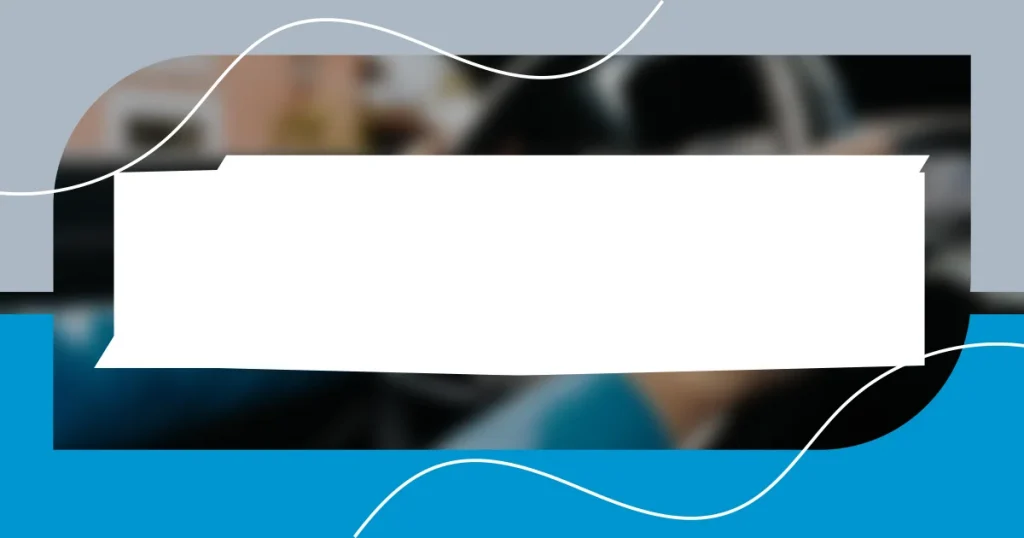Key takeaways:
- Technological disruptions can reshape industries and require an adaptive mindset to view them as opportunities for innovation rather than threats.
- Recognizing early warning signs, such as changes in consumer behavior and emerging technologies, is essential for anticipating disruptions.
- Adopting agile strategies and a continuous learning mindset promotes resilience and adaptability, allowing organizations to thrive amid rapid technological changes.

Understanding technological disruptions
Technological disruptions occur when innovation fundamentally alters existing industries or patterns of behavior. I remember when smartphones emerged; my daily routine transformed almost overnight. Can you think of a time when a new technology reshaped your life or work in a significant way?
These shifts often come with a wave of both excitement and fear. I felt exhilarated and anxious when I first encountered artificial intelligence in my workplace. Will this technology empower us, or will it render certain jobs obsolete? It’s a complex dance between adaptation and resistance.
Understanding these disruptions means acknowledging that they’re both challenges and opportunities. I’ve learned to embrace change, viewing each disruption as a chance to innovate rather than a threat to my stability. How do you perceive these changes? It’s all about cultivating a mindset that sees potential in the face of uncertainty.

Recognizing early warning signs
Recognizing early warning signs is crucial for staying ahead of technological disruptions. I recall noticing the gradual integration of automation in manufacturing during my early career. At first, it seemed like a distant concept, but then I saw how it streamlined operations and cut costs. The shift was subtle, but those who paid attention could see that change was inevitable.
It’s fascinating to me how consumer behavior often hints at larger technological trends. When I observed friends increasingly relying on streaming services instead of traditional cable, I knew something significant was happening. These patterns can signal the emerging capabilities of technology that can reshape entire sectors. Developing a keen eye for these shifts has been invaluable in my journey to anticipate change.
I often ask myself, what small trends are emerging around me? Whether it’s social media usage or virtual reality experiences, these can serve as early indicators of broader disruptions. By engaging regularly with my network and remaining curious about new tools, I can often catch those subtle signals that many overlook. It’s about being proactive and responsive to what’s unfolding right at our doorstep.
| Warning Sign | Personal Experience |
|---|---|
| Consumer Shifts | Noticing friends switching to streaming services alerted me to potential disruptions in entertainment. |
| Technological Integration | Seeing automation in manufacturing sparked questions about efficiency and the future of jobs. |
| Networking Insights | Engaging with peers on emerging tech often reveals trends that could influence my field. |

Adopting a continuous learning mindset
Adopting a continuous learning mindset is essential in an age where technology evolves at breakneck speed. Personally, I’ve found that my greatest growth comes from seeking out new knowledge and experiences. For instance, after attending a workshop on machine learning, I not only understood its basics but also gained practical insights on how it could impact my work. It was an eye-opening experience that sparked my curiosity about the tools I could incorporate into my projects.
To nurture this mindset, I focus on several key practices:
- Embrace Lifelong Learning: I’ve made it a habit to read regularly—anything from industry reports to tech blogs—to stay informed on new trends.
- Join Online Courses: Platforms like Coursera or Udemy offer courses that I can fit into my schedule, allowing me to explore areas outside my expertise.
- Engage in Learning Communities: I’ve joined local meetups and online forums where exchanging ideas with peers has led to exciting discussions and collaborations.
- Reflect on Experiences: After attending events or completing courses, I take time to reflect on what I’ve learned and how I can apply it to my work.
By making continuous learning a priority, I cultivate resilience and adaptability. This not only opens doors for me but also fuels my passion for embracing change and innovation amid uncertainty.

Leveraging data for informed decisions
Being able to leverage data effectively makes a significant difference in how I make decisions. I remember a time when I analyzed customer feedback trends for a product launch. By digging into the data, I discovered what features potential users truly valued—insights that shaped our marketing strategy. It was humbling to realize that the numbers could guide our direction so clearly and definitively.
It’s intriguing how data can also reveal unexpected opportunities. Once, I chose to track engagement metrics from our social media campaigns. The results indicated an unexpected demographic showing interest in our content. Recognizing that audience shift prompted me to tailor our messaging, ultimately boosting our reach and impact. Have you ever looked closely at your data and found something surprising? That moment of realization can be incredibly rewarding.
In my experience, the right data helps eliminate the guesswork in decision-making. When I shifted to a data-driven approach, I felt more confident about my choices. It’s like having a compass in a dense forest—without it, everything feels uncertain. By continually assessing and interpreting the data, I’ve been able to stay proactive rather than reactive, which has been crucial in navigating the ever-changing tech landscape.

Implementing agile strategies for adaptation
Implementing agile strategies is something I genuinely embrace, especially in today’s rapidly changing technological landscape. During a project launch last year, we faced unexpected challenges—market demands shifted almost overnight. Instead of feeling overwhelmed, our team employed short sprints to quickly adapt our product features based on real-time feedback. This approach allowed us not just to survive but to thrive by being responsive to our clients’ needs.
I often find that the flexibility of agile methodologies empowers my team to take ownership of our processes. One memorable instance was when we decided to hold daily stand-up meetings. These brief check-ins transformed our workflow, enabling us to pinpoint issues swiftly before they snowballed into bigger problems. Have you ever experienced a similar turnaround just because of open communication? For me, it was a great reminder that sometimes the simplest changes can have the most profound impact.
Adopting an iterative mindset has been liberating. Instead of aiming for perfection from the start, I’ve learned to prioritize progress and experimentation. When I launched a new marketing initiative recently, the initial results were far from ideal. Instead of scrapping it, I took the opportunity to refine our tactics based on initial feedback. This continuous cycle of testing and learning not only boosted my confidence but also reinforced my belief that adaptability is key to staying ahead. How do you approach challenges? Embracing agility has taught me to see every obstacle as a potential stepping stone.

Evaluating and refining your approach
Evaluating and refining my approach has always been a cornerstone of my experience in navigating technological disruptions. I recall attending a workshop on strategic review methods; the session really opened my eyes to the importance of regular self-assessment. I learned that just because something worked last year doesn’t mean it’s still effective today. Have you ever felt stuck in a routine that no longer serves you? It’s a freeing realization to acknowledge that improvement is always possible.
In practice, I frequently conduct what I call “reflection sessions,” where I assess my strategies and outcomes. For instance, after one particularly challenging quarter, I gathered my team for a brainstorming session. We dissected our campaigns, discussing what resonated and what fell flat. It was surprising how much clarity emerged from that open dialogue; together, we identified fresh avenues for improvement. Those conversations not only offered valuable insights but also reinforced our team’s camaraderie. How often do you encourage open discussions like this in your own work environment?
It’s fascinating how incorporating feedback loops helps refine my approach. I remember that during a product upgrade, I decided to set up a survey for our users. The responses were brutally honest but incredibly insightful, leading me to rethink our design entirely. By embracing constructive criticism instead of taking it as a hit to my ego, I found a renewed commitment to excellence. This experience taught me that every evaluation is a chance to discover new paths and create meaningful change in my work. Have you experienced a similar breakthrough prompting a significant shift in your perspective?
















